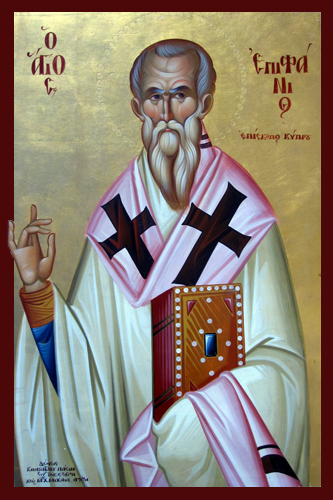Saint Epiphanius the Bishop of Cyprus
Saint Epiphanius, Bishop of Cyprus, “a last relic of ancient piety,” as St. Jerome calls him, lived during the fourth century in Phoenicia. The Roman empress Honoria was his sister. He was of Jewish descent, and in his youth he received a fine education. He was converted to Christianity  after seeing how a certain monk named Lucian gave away his clothing to a poor person. Struck by the monk’s compassion, Epiphanius asked to be instructed in Christianity.
after seeing how a certain monk named Lucian gave away his clothing to a poor person. Struck by the monk’s compassion, Epiphanius asked to be instructed in Christianity.
He was baptized and became a disciple of St. Hilarion the Great (October 21). Entering the monastery, he progressed in the monastic life under the guidance of the experienced Elder Hilarion, and he occupied himself with copying Greek books.
Because of his ascetic struggles and virtues, St. Epiphanius was granted the gift of wonderworking. In order to avoid human glory, he left the monastery and went into the Spanidrion desert. Robbers caught him there and held him captive for three months. By speaking of repentance, the saint brought one of the robbers to faith in the true God. When they released the holy ascetic, the robber also went with him. St. Epiphanius took him to his monastery and baptized him with the name John. From that time, he became a faithful disciple of St. Epiphanius, and he carefully documented the life and miracles of his instructor.
Reports of the righteous life of St. Epiphanius spread far beyond the monastery. The saint went a second time into the desert with his disciple John. Even in the wilderness disciples started to come to him, so he established a new monastery for them.
After a certain time, St. Epiphanius made a pilgrimage to Jerusalem to venerate its holy shrines, and then returned to the Spanidrion monastery. The people of Lycia sent the monk Polybios to St. Epiphanius asking him to take the place of their dead archpastor. When he learned of this intention, the clairvoyant ascetic secretly went into the Pathysian desert to the great ascetic St. Hilarion (October 21), under whose guidance he had learned asceticism in his youth.
The saints spent two months in prayer, and then Hilarion sent St. Epiphanius to Salamis. Bishops were gathered there to choose a new archpastor to replace one who recently died. The Lord revealed to the eldest of them, Bishop Papius, that St. Epiphanius should be chosen bishop. When Epiphanius arrived, St. Papius led him into the church, where in obedience to the will of the participants of the Council, Epiphanius agreed to be their bishop. St. Epiphanius was consecrated as Bishop of Salamis in 367.
St. Epiphanius won renown because of his great zeal for the Faith, his love and charity toward the poor, and his simplicity of character. He suffered much from the slander and enmity of some of his clergy. Because of the purity of his life, St. Epiphanius was permitted to see the coming of the Holy Spirit upon the Gifts at Divine Liturgy. Once, when the saint was celebrating the Mystery, he did not see this vision. He then became suspicious of one of the clergy and quietly said to him, “Depart, my son, for you are unworthy to participate in the celebration of the Mystery today.”
At this point, the writings of his disciple John break off, because he became sick and died. The further record of the life of St. Epiphanius was continued by another of his disciples, Polybios (afterwards bishop of city of Rinocyreia).
Through the intrigues of the empress Eudoxia and the Patriarch Theophilos of Alexandria, towards the end of his life St. Epiphanius was summoned to Constantinople to participate in the Synod of the Oak, which was convened to judge the great saint, John Chrysostom (September 14 and November 13). Once he realized that he was being manipulated by Chrysostom’s enemies, St. Epiphanius left Constantinople, unwilling to take part in an unlawful council.
As he was sailing home on a ship, the saint sensed the approach of death, and he gave his disciples final instructions: to keep the commandments of God, and to preserve the mind from impure thoughts. He died two days later. The people of Salamis met the body of their archpastor with carriages, and on May 12, 403 they buried him in a new church which he himself had built.
The Seventh Ecumenical Council named St. Epiphanius as a Father and Teacher of the Church. In the writings of St. Epiphanius, the PANARIUM and the ANCHORATUS are refutations of Arianism and other heresies. In his other works are found valuable church traditions, and directives for the Greek translation of the Bible.
In his zeal to preserve the purity of the Orthodox Faith, St. Epiphanius could sometimes be rash and tactless. In spite of any impetuous mistakes he may have made, we must admire St. Epiphanius for his dedication in defending Orthodoxy against false teachings. After all, one of the bishop’s primary responsibilities is to protect his flock from those who might lead them astray.
We also honor St. Epiphanius for his deep spirituality, and for his almsgiving. No one surpassed him in his tenderness and charity to the poor, and he gave vast sums of money to those in need.

2025-12-01
Address of Patriarch JOHN X The…
2025-11-24
Delegation from the Hungarian…
2025-11-22
The Antioch Patriarchate Index…
2025-11-21
His Beatitude John X, Meets…
2025-11-19







